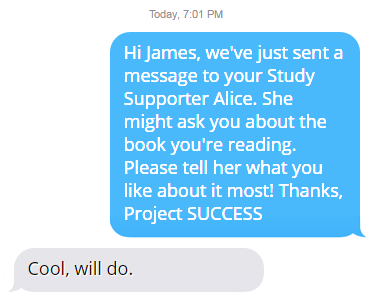At BIT, we send a lot of text messages. It’s not just us – other behavioural scientists use them a lot too. In fact, you could wonder aloud whether we have any other ideas.
In the last six years we’ve used text messages to increase fine repayments, GCSE pass-rates, University engagement, and the quality of parenting in refugee camps, and to reduce missed appointments at hospitals, and rates of reoffending. These seemingly simple interventions can have surprisingly large effects, from one-off alerts (reducing missed appointments by 25%) to a year-long programme of texts (increasing maths and English pass rates by 27%). Through BI Ventures we’ve even built our own online platform Promptable, which takes some of our most successful text message interventions to scale and makes running large scale texting trials easier to manage.

Why do we text as much as we do? People often ask why, at the Behavioural Insights Team, we don’t use Whatsapp, or Slack, or Facebook Messenger (or the latest flavour of tech) instead? There are a few reasons:
Low cost
Text messages are cheap at about 4 pence (160 characters), pretty much everywhere in the world. They allow you to get a message into the hands of your intended target, quickly, and without spending a lot of money. Behavioural interventions can have modest effects, so they need to be delivered cheaply to be cost effective. Their low cost also make text messaging interventions easy to deliver at scale.
Make it easy
One of the most important rules in behavioural insights is, according to Nobel Prize winner Richard Thaler, “make it easy”. Often this means giving a direct call to action – ‘turn up to your appointment’, or ‘pay your fine’. A text message makes it clear. Texts are certainly not the only way to deliver simple prompts, but they can be automated and triggered by specific events. Integration with data management systems allow administrators to send personalised texts about attendance, deadlines, or outstanding tasks without even having to press a button.
160 characters helps us stick with the essentials
Even when we’re trying to be concise, it’s easy to add too much information that isn’t helpful and can confuse people. The default size of a letter is a single sheet of paper, so it’s easy not to be brief. Plus, if you’re a bit long-winded – there’s another piece waiting for you overleaf. The character limits on sending a message tie your hands – committing you to brevity and simplicity.
Universality
The other key to making meaningful impacts with nudges is scale – we’ve already seen that a small increase in tax repayment rates, spread over thousands of people, leads to millions of pounds of extra revenue. Mobile phones are widespread – according to Ofcom only 7% of people don’t own or regularly use a mobile in the UK, yet twice as many, a full 14% of people, live in a home with only mobile phones, and no landline. At the same time, only 76% of adults in the UK have smartphones – even if all of them downloaded an app like WhatsApp, that’s still millions fewer than can be reached by text (plus, everyone with WhatsApp can receive a text). For our Project SUCCESS trial, 59% of students in further education colleges nominated a parent or grandparent as their study supporter. If older people are less likely to have smartphones with the latest app on them, that’s a lot of people who wouldn’t be able to benefit from the programme.
Acceptability
It might feel acceptable for an old classmate to contact you via Messenger or WhatsApp, but the same standards probably don’t apply to your GP, teacher or local government official. When we interviewed students about the acceptability of our texting intervention, they felt rather strongly about the timing, frequency and personalisation of the programme. They didn’t, for example, like the idea of receiving texts on Sunday nights or bank holidays. Communication software like WhatsApp blurs the boundaries between public and private, by allowing both sender and recipient to see when the message was read, and whether the other party is currently online.
The hurdle of apps
We started off by comparing texts against traditional communication tools, like emails or letters. But there’s also an obvious benefit of text messages in comparison to apps or other forms of online communication, even though the latter are typically free and popular. To deliver a programme of texts, your recipients won’t need to install anything; they won’t need to accept an invite to connect, or download an app to their phone. Contrast this with Facebook Messenger or Whatsapp where active consent is needed before recipients can be contacted. Or imagine asking people to download a bespoke app: they might uninstall it within weeks or months, or never even open it. Indeed, recent app usage data shows that 77% of people stop using an app (daily) within the first 3 days of the install.
And last but not least, SMS still have a special status on most mobile devices. Whereas app notifications are easily (and often) silenced, very few people turn off text notifications. That means it will appear, even on your lock screen, whereas other forms of communication might get lost in the continuous stream of pings and pop-ups.
Texting may seem old hat in 2018, but as long as it remains a cheap, salient and timely method of communicating with people, it’s here to stay in the Behavioural Scientist’s toolkit.




